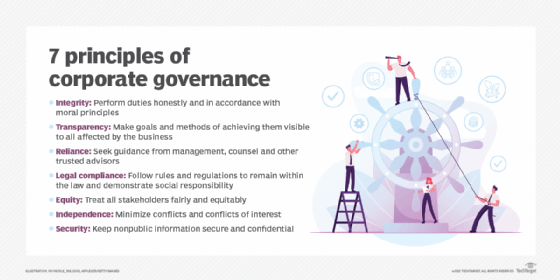
Getty Images
What does the 'G' in ESG mean?
ESG is a framework for evaluating a company's commitment to sustainability. Learn how the 'G' -- governance -- helps companies operationalize the other two components.
Governance is a crucial part of ESG, but it's often overlooked.
In talks about ESG, most focus on the risks and opportunities related to the "E" -- environmental -- and "S" -- social -- components. Topics such as climate change; sustainability; and diversity, equity and inclusion (DEI) fall into these categories. When a business talks about reducing their carbon emissions, that's E. When a business talks about ethical supply chains, that's S. They have a broader appeal that many people understand outside of the business world.
What's frequently overlooked, though equally important, is the "G" -- governance. Governance is the way a corporation governs itself and conducts business operations. The makeup of the board of directors; corporate transparency; and the allotment of different rights and responsibilities to management, shareholders and stakeholders are all part of corporate governance. Integrity, transparency, responsibility, equity and risk management are some basic principles of governance.
How does governance relate to environmental and social factors?
Governance is important because it sets the rules, policies and procedures that help organizations meet business targets along with environmental and social targets. Effective governance makes sure that environmental and social policies are created, implemented and adhered to. Governance, environmental and social factors form a framework to measure how an organization operates ethically, sustainably and responsibly.
ESG reporting also shows investors that companies adhere to responsible practices -- such as ethical supply chain management, DEI programs and carbon accounting -- and helps them avoid companies that engage in risky practices. Environmental, social and governance factors all affect a company's risk management and business strategies and, therefore, affect the company's bottom line. Governance sets the procedures, policies and broad strategies that control the company's approach to the other two factors.

What are the components of governance?
Below are some examples of business components that governance controls:
- Board composition. Board composition refers to the composition and structure of the board; diversity among board members; oversight capacity; and independence from the company, meaning board members are outsiders that act in the best interests of the company and its stakeholders.
- Business integrity. Business integrity involves anti-corruption measures such as whistleblower protocols, preventing conflicts of interest, record keeping and financial controls, reporting and accounting, and internal investigation and remediation.
- Corporate leadership. Corporate leadership pertains to the quality, decision-making and strategic direction provided by a company's leaders. It also ensures the compliance function of corporate leadership is working and able to influence decisions.
- Competitive practices. Governance holds the business to fair competitive practices by implementing anti-collusion, anti-monopoly, anti-exclusion, and anti-coercion policies and procedures.
- Ethics. Governance helps ensure the business acts with integrity and pursues its purpose and values beyond just compliance. The business fosters a culture to support business integrity and a reporting framework for key performance indicators (KPIs) related to its purpose and values.
- Incentive structures. Incentive structures within a company dictate how employees and management are motivated and rewarded, influencing their performance and behavior. It includes compensation structures and promotion policies as well as reporting frameworks for each. It also includes defined misconduct and disciplinary procedures.
- Political activities. Governance of corporate political activities involves how a company engages with political entities and addresses its role in the political landscape. It includes a company's lobbying efforts, campaign financing and political contributions.
- Transparency. Transparency is about the openness and clarity with which a company shares information with its stakeholders and the public. The company discloses ownership, subsidiaries, public contracts, charitable donations and the countries in which it operates. The company's disclosures should be verifiable to build trust with stakeholders and comply with regulatory requirements.
- Tax strategy. Tax strategy involves how a company manages its tax obligations and strategies in a responsible and legal manner. It includes how the company handles tax compliance, tax disclosures and tax avoidance.
- Risk management. Risk management involves the processes and strategies a company employs to mitigate and manage potential risks and crises. It involves preparedness through understanding of past risk management performance, risk mitigation, information governance and cybersecurity. It also involves adhering to regulatory compliance and using independent auditors to provide authentic, verifiable assessments of a company's risk management practices.
- Resource allocation. Resource allocation refers to how a company allocates its financial, human and material resources in its operations. It involves human capital management as well as mergers and acquisitions.
- Stakeholder priorities. Stakeholder engagement is the process of involving and communicating with those who have an interest or stake in the company. The company implements stakeholder-centric policies and procedures.
- Supply chain management. Supply chain management refers to how a company manages its supply chain and value chain activities responsibly and efficiently. This involves disclosing countries of origin and contractual obligations, as well as implementation of sustainable practices across the supply chain.
The way these components are implemented varies by industry and local context.
What are some examples of governance in ESG?
Governance is important because it steers the strategic direction of the company and assures company accountability. It is often considered as important as profitability in a business. Bad governance can lead to a spectrum of negative outcomes, including failure to reach company goals, loss of stakeholder or community support, and loss of finances.
Some notable real-world examples of good and bad governance include the following.
FTX
FTX, a prominent cryptocurrency exchange, displayed a lack of corporate controls under founder and former CEO Sam Bankman-Fried. In 2023, Bankman-Fried was convicted of fraud. FTX had faulty regulatory oversight and a lack of centralized cash handling control. Corporate funds were also used to make luxury purchases for FTX employees.
The FTX scandal is a case of bad corporate governance.
Twitter/X
Under Elon Musk's leadership, X, formerly known as Twitter, faced controversy around changes in governance policies. Musk laid off 80% of the company's workforce in the weeks following his takeover of the platform. This, combined with changes in the content moderation policy that many say emboldened hate speech and pushed misinformation, caused more than 500 of Twitter's advertisers to withdraw from the platform.
Twitter suffered significant financial and reputational damage. In this instance, Twitter showed deficiencies in the corporate leadership, stakeholder priorities and resource allocation components of governance.
Patagonia
Outdoor apparel company Patagonia has worked to reduce its environmental footprint within its own business and throughout its supply chain. The company's effort includes transitioning to 100% renewable energy for its globally owned and operated stores, offices and distribution centers. Patagonia has switched to using only organically grown cotton in all its virgin cotton-made products and is increasing its use of preferred materials. Patagonia also cofounded or joined numerous progressive coalitions to change the industry, focusing on improving workplaces around the world.
Patagonia exemplifies good governance in the supply chain management, ethics and integrity components of governance, in part by pursuing the company mission beyond just regulatory compliance.
Unilever
Consumer packaged goods manufacturer Unilever outlines its commitment to ESG in its 2023 governance report. This strategy includes goals to improve the company's effect on the planet. For example, it aims to transition to renewable energy and expand its plant-based product range. The company also defines the roles of the board and the responsibilities that the board delegates to the company's senior leadership. Moreover, the company discloses progress toward its Climate Transition Action Plan.








